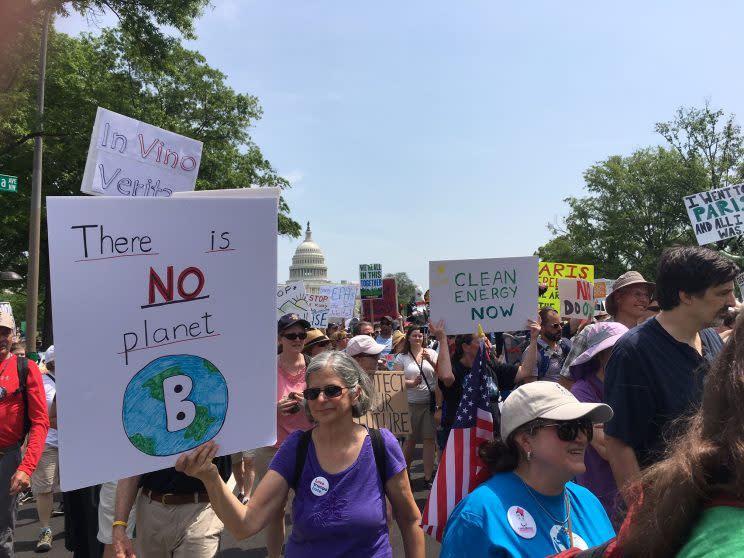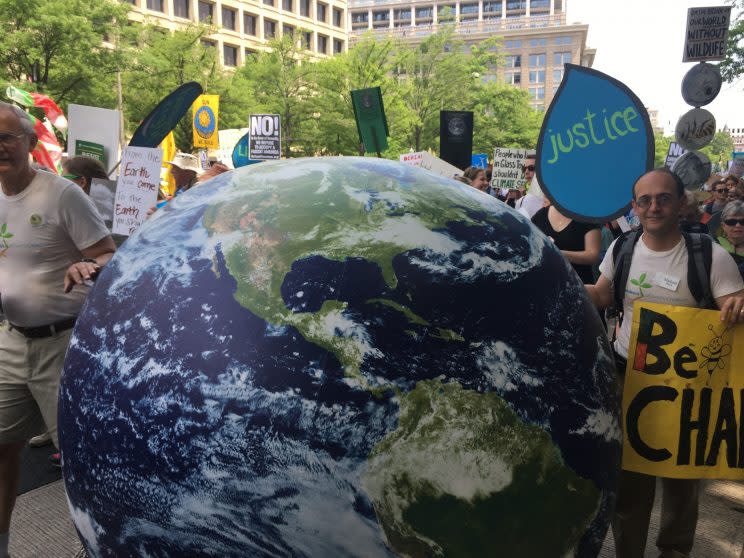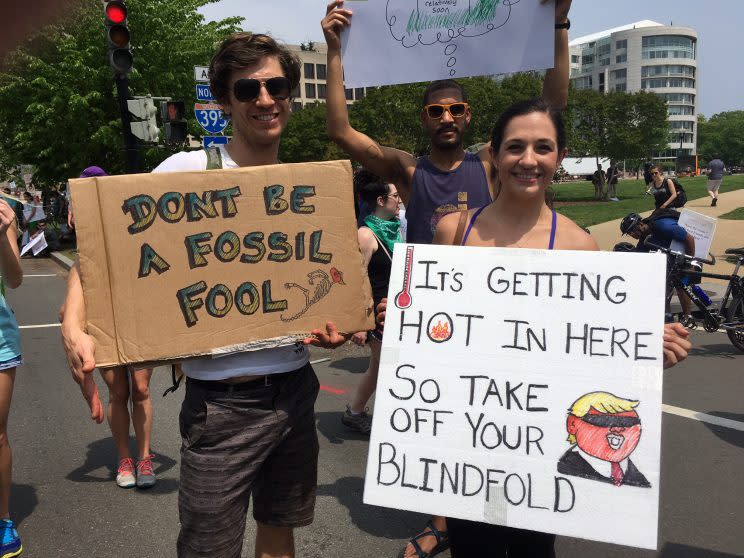Peoples Climate March hits D.C. with new goals for the Trump era

WASHINGTON — Although these are dark days for environmentalists, the Peoples Climate March had a cheerful air Saturday afternoon as it took over the streets surrounding the federal government in Washington, D.C.
According to the event’s organizers, more than 200,000 people came from across the country to gather in the swamp’s humidity. (Apropos of the day’s event, the temperature soared past 90°F.) More than 400 official buses brought attendees to D.C., and there were some 300 satellite marches around the country.
Marchers started in front of the Capitol Building, filled out the length of Pennsylvania Avenue, and marched down to the White House. There they split in two, symbolically surrounding the White House and the longtime climate-science denier who occupies it. Then they filtered down to the National Mall. Splayed in front of the Washington Monument, they listened to speeches from front-line environmental justice activists hailing from Brooklyn to San Francisco and points halfway in between, such as the Standing Rock Sioux Reservation in South Dakota.
Giant orbs rolled along representing Earth, and lighthearted signs made reference to the planet with slogans such as “Respect your mother.” Some posters mocked President Trump with slightly dark wisecracks such as “Mar-a-Lago elevation: 3 feet. It’s not all bad.” Some, such as those warning that “There is no Planet B,” were darker still. Others were meant to inspire with slogans such as “The seas are rising but so are we.”
The number of comedic political T-shirts rivaled sincere ones. Yahoo News spotted only one Hillary 2016 shirt, but three representing joke candidates for 2020: Stewart/Colbert, the Big Lebowski and Kanye West.

Slideshow: People’s Climate March across the U.S. >>>
Borrowing from the playbook of conservative Tea Party activists, Harold Fuller-Bennett of Takoma Park, Md., dressed up in Revolutionary War garb. Standing along Pennsylvania Avenue blowing his horn, Fuller-Bennett explained that he was Paul Revere, there to warn the citizens about climate change. His sign helpfully hinted at Revere’s famous ride with the phrase “One if by land, two if by sea,” and Fuller-Bennett consistently issued two honks of the horn to reference the rising seas.
Compared to the March for Science a week earlier, Saturday’s demonstration was more overtly political. When marchers passed the Trump International D.C. hotel on Pennsylvania Avenue, they started shouting, “Shame, shame” and “Check out.” Many had posters and even puppets depicting Trump in various evil poses, such as holding the Earth on a string like a yo-yo.
Only a small number of the messages called for specific policy decisions, but this is perhaps unsurprising given Trump’s hostility toward climate science and environmental regulation. The massive cuts in Trump’s proposed budget to environmental regulation and scientific research did come up, though. And a former Environmental Protection Agency official spoke at the rally on the importance of the bureau’s work. Some marchers chanted “Save the EPA,” “No Keystone,” and carried anti-Trump signs such as “Keep your tiny hands off NASA’s climate research.”
Rather than attracting stereotypical gray-ponytailed Birkenstock-shod tree-huggers, this event reflecting the organizers’ emphasis on diversity and environmental and economic justice. Participants were racially diverse, often quite young, with contingents hailing from across the coalition that co-sponsors the Peoples Climate Movement, which includes a range of labor unions, social and racial justice groups, and environmental advocacy organizations.
But the political context for these activists is daunting. Just the day before, Trump issued an executive order to the Department of Interior that may result in opening up parts of the Arctic, Atlantic and Pacific oceans to offshore oil and gas drilling. In March, Trump began the process of repealing the Clean Power Plan that would have limited carbon emissions from coal-fired power plants. And the world anxiously awaits the Trump administration’s decision on whether it will pull the U.S., the world’s largest cumulative greenhouse-gas emitter and largest economy, out of the Paris climate agreement.

This is dramatically different from the conditions surrounding the previous Peoples Climate March, held in New York City in September 2014, which brought hundreds of thousands of people to pressure then-President Barack Obama and other world leaders in advance of that year’s United Nations Climate Summit. In that case, they were pushing a friendly administration, and the march was followed by Obama ramping up domestic climate action and international climate diplomacy, laying the groundwork for successful climate negotiations in Paris the next year.
Unlike the past week, when Trump felt compelled to issue statements in response to the science march, the president did not tweet or issue a statement on the climate march. (During a Saturday night rally in Harrisburg, Pa., Trump attacked the Paris accord and declared that he’d be making a “big decision” about it within two weeks.)
But swaying the White House into bold action was not a goal for Saturday’s event.
Organizers said that this time, their goals are more modest: largely, to build connections between activists of different backgrounds and focuses on varied issues, and to boost to their enthusiasm for defending the Obama administration’s climate policies while making incremental progress at the state and local levels. This was a sentiment echoed by rank-and-file march attendees. Jim Lively, a local environmental activist from northern Michigan, took a 14-hour bus ride to D.C. with 54 others from his community, with no expectation of effecting immediate policy changes. “It’s not about Trump,” said Lively. “It’s about us: to be with each other, find people to connect with and energize.”
Others marchers suggested that seeing news of such a large turnout might inspire apathetic liberals. “If I was young and I saw this on TV, I’d think this is cool,” said D.J. Fernandez, 26, of Rockville, Md. (Apparently, 26 no longer counts as young.)
Rep. Eliot Engel, D-N.Y., echoed that sentiment. “We have to show people who didn’t vote why it matters,” he said. “If we can get millennials to vote, then we can win elections even if we don’t convert Republicans.”
Read more from Yahoo News’ coverage of Trump’s first 100 days:
Donald Trump doesn’t talk like other presidents. Would he be a better president if he did?
What Trump has done for, and to, the environment in his first 100 days
The Ever-Trumpers: Revisiting his backers from 2016, we find they still like him
Fact check: The White House’s claims about Trump’s first 100 days
The contrarians: They didn’t vote for Trump, but they would now
Trump foreign policy at 100 days: The downside of unpredictability
Twitter, Mar-a-Lago and Obama bashing: The 45th president’s 100 days of norm-busting
Photos: From inauguration to 100th day — President Trump’s rocky ride in pictures
Photos: From crude to creative — 100 days of Trump signs wielded by fans and foes




